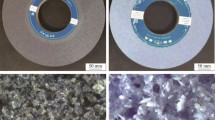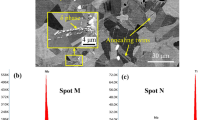Abstract
High-speed grinding with cubic boron nitride (CBN) electroplated wheels has been widely used in the aviation manufacturing field, such as the machining of nickel-based and titanium alloys. The requirement of dimensional precision and consistency of parts can be met effectively because of the high feasibility and grinding performance of CBN electroplated wheels. Meanwhile, surface integrity has a direct and significant effect on the fatigue behavior of workpieces. Therefore, the influence of surface integrity machined by CBN electroplated wheels on fatigue behavior of Inconel 718 and Ti6Al4V specimens is investigated. Based on the experimental results of surface roughness, microhardening rate, and residual stress measured, low-cycle fatigue tests were carried out to analyze the influence mechanisms of surface integrity on low-cycle fatigue life. Under the given experimental conditions, it can be obtained that surface roughness has predominant and negative effects on the number of cycles to failure (Nf) of Inconel 718 specimens when surface roughness is higher than Ra 0.4 μm. However, when surface roughness is less than Ra 0.3 μm, surface microhardening rate has predominant and positive effects on Nf. Compared with polished specimens, Nf of ground specimens can be increased by 47.5% utilizing the optimized parameters and conditions. As for Ti6Al4V specimens, both surface roughness and microhardening rate have negative effects on Nf. Micro-recast layer and molten drops have been observed on machined surface of Ti6Al4V specimens, which have significant and negative effects on the fatigue behavior of workpieces. At the same time, Nf of ground specimens with CBN electroplated wheels is less than that of milled specimens even utilizing the optimized grinding parameters. From all the comparison results, it can be achieved that the influence mechanisms of surface integrity on fatigue behavior of Inconel 718 and Ti6Al4V specimens with CBN electroplated wheels are different due to the material properties.
Similar content being viewed by others
References
Ulutan D, Ozel T (1994) Machining induced surface integrity in titanium and nickel alloys: a review. Int J Mach Tools Manuf 51(3):250–280. https://doi.org/10.1016/j.jmatprotec.2018.09.003
M'Saoubi R, Axinte D, Soo SL, Nobel C, Attia H, Kappmeyer G, Engin S, Sim WM (2015) High performance cutting of advanced aerospace alloys and composite materials. CIRP Ann-Manuf Technol 64(2):557–580. https://doi.org/10.1016/j.cirp.2015.05.002
Jackson MJ, Davis CJ, Hitchiner MP, Mills B (2001) High-speed grinding with CBN grinding wheels—applications and future technology. J Mater Process Technol 110(1):78–88. https://doi.org/10.1016/S0924-0136(00)00869-4
Klocke F, Klink A, Veselovac D, Aspinwall DK, Soo SL, Schmidt M, Schilp J, Levy G, Kruth JP (2014) Turbomachinery component manufacture by application of electrochemical, electro-physical and photonic processes. CIRP Ann 63(2):703–726. https://doi.org/10.1016/j.cirp.2014.05.004
Tso PL (1995) Study on the grinding of Inconel 718. J Mater Process Technol 55(3):421–426. https://doi.org/10.1016/0924-0136(95)02026-8
Yao CF, Jin QC, Huang XC, Wu DX, Ren JX, Zhang DH (2013) Research on surface integrity of grinding Inconel 718. Int J Adv Manuf Technol 65(5):1019–1030. https://doi.org/10.1007/s00170-012-4236-7
Wang Y, Li C, Zhang Y, Yang M, Li B, Jia D, Hou Y, Mao C (2016) Experimental evaluation of the lubrication properties of the wheel/workpiece interface in MQL grinding with different nanofluids. Tribol Int 99:198–210. https://doi.org/10.1016/j.jclepro.2016.03.121
Sinha MK, Setti D, Ghosh S, Rao PV (2016) An investigation on surface burn during grinding of Inconel 718. J Mater Process Technol 21:124–133. https://doi.org/10.1016/j.jmapro.2015.12.004
Turley DM (1985) Factors affecting surface finish when grinding titanium and a titanium alloy (Ti-6Al-4V). Wear 104(4):323–335. https://doi.org/10.1016/0043-1648(85)90040-7
Xu X, Yu Y, Huang H (2003) Mechanisms of abrasive wear in the grinding of titanium (TC4) and nickel (K417) alloys. Wear 255(7):1421–1426. https://doi.org/10.1016/S0043-1648(03)00163-7
Teicher U, Künanz K, Ghosh A, Chattopadhyay AB (2008) Performance of diamond and CBN single-layered grinding wheels in grinding titanium. Mater Manuf Process 23(3):224–227. https://doi.org/10.1080/10426910701860541
Sadeghi MH, Haddad MJ, Tawakoli T, Emami M (2009) Minimal quantity lubrication-MQL in grinding of Ti-6Al-4V titanium alloy. Int J Adv Manuf Technol 44(5):487–500. https://doi.org/10.1007/s00170-008-1857-y
Huang Q, Ren JX (1991) Surface integrity and its effects on the fatigue life of the nickel-based superalloy GH33A. Int J Fatigue 13(4):322–326. https://doi.org/10.1016/0142-1123(91)90359-7
Kawagoishi N, Chen Q, Kondo E, Goto M, Nisitani H (1999) Influence of cubic boron nitride grinding on the fatigue strengths of carbon steels and a nickel-base superalloy. J Mater Eng Perform 8(2):152–158. https://doi.org/10.1361/105994999770346981
Bentley SA, Mantle AL, Aspinwall DK (1999) The effect of machining on the fatigue strength of a gamma titanium aluminide intertmetallic alloy. Intermetallics 7(8):967–969. https://doi.org/10.1016/S0966-9795(99)00008-4
Klocke F, Welling D, Dieckmann J (2011) Comparison of grinding and wire EDM concerning fatigue strength and surface integrity of machined Ti6Al4V components. Procedia Eng 19:184–189. https://doi.org/10.1016/j.proeng.2011.11.099
ASTM E466-15 (2015) Standard practice for conducting force controlled constant amplitude axial fatigue tests of metallic materials. Standard, ASTM International. https://doi.org/10.1520/E0466-15
Yao C, Wu D, Jin Q, Huang X, Ren J, Zhang D (2013) Influence of high-speed milling parameter on 3D surface topography and fatigue behavior of TB6 titanium alloy. Trans Nonferrous Metals Soc China 23(3):650–660. https://doi.org/10.1016/S1003-6326(13)62512-1
Webster GA, Ezeilo AN (2001) Residual stress distributions and their influence on fatigue lifetimes. Int J Fatigue 23:375–383. https://doi.org/10.1016/S0142-1123(01)00133-5
Ross AS, Morrow JD (1960) Cycle-dependent stress relaxation of A-286 alloy. J Fluids Eng – Trans ASME 82(3):654–658. https://doi.org/10.1115/1.3662690
Zhuang WZ, Halford GR (2001) Investigation of residual stress relaxation under cyclic load. Int J Fatigue 23(1):31–37. https://doi.org/10.1016/S0142-1123(01)00132-3
McClung RC (2007) A literature survey on the stability and significance of residual stresses during fatigue. Fatigue Fract Eng Mater Struct 30(3):173–205. https://doi.org/10.1111/j.1460-2695.2007.01102.x
Neuber H (1958) Kerbspannungsleshre. Springer-Verlag, Berlin, pp 159–163
Arola D, Williams CL (2002) Estimating the fatigue stress concentration factor of machined surfaces. Int J Fatigue 24(9):923–930. https://doi.org/10.1016/S0142-1123(02)00012-9
Kullmer G, Richard HA (2006) Influence of the root radius of crack-like notches on the fracture load of brittle components. Arch Appl Mech 76(11):711–723. https://doi.org/10.1007/s00419-006-0089-6
Soo SL, Hood R, Lannette M, Aspinwall DK, Voice WE (2011) Creep feed grinding of burn-resistant titanium (BuRTi) using superabrasive wheels. Int J Adv Manuf Technol 53(9):1019–1026. https://doi.org/10.1007/s00170-010-2876-z
Rowe WB, Jin T (2001) Temperatures in high efficiency deep grinding (HEDG). CIRP Ann 50(1):205–208. https://doi.org/10.1016/S0007-8506(07)62105-2
Qi HS, Mills B, Xu XP (2009) Applications of contact length models in grinding processes. Key Eng Mater 404:113–122. https://doi.org/10.4028/www.scientific.net/KEM.404.113
Acknowledgements
The authors thank the anonymous reviewers for their critical and constructive reviews of the manuscript. This study was co-supported by the Natural Science Foundation of China (Grant No. 51875028), the National Science and Technology Major Project of China (No. 2018ZX04005001), and the Aeronautical Science Foundation of China (No. 2016ZE51039).
Author information
Authors and Affiliations
Corresponding author
Ethics declarations
Conflict of interest
The authors declare that they have no conflict of interest.
Additional information
Publisher’s note
Springer Nature remains neutral with regard to jurisdictional claims in published maps and institutional affiliations.
Rights and permissions
About this article
Cite this article
Li, X., Wang, Y., Xu, R. et al. Influence of surface integrity on fatigue behavior of Inconel 718 and Ti6Al4V workpieces with CBN electroplated wheel. Int J Adv Manuf Technol 102, 2345–2356 (2019). https://doi.org/10.1007/s00170-019-03345-6
Received:
Accepted:
Published:
Issue Date:
DOI: https://doi.org/10.1007/s00170-019-03345-6




